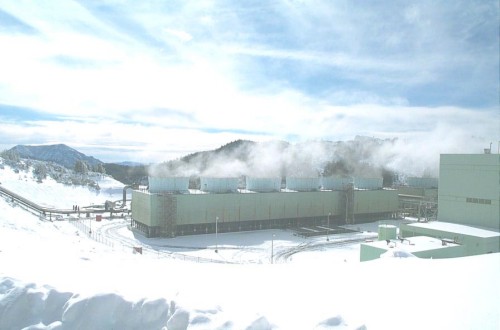While waiting for Calpine’s announcement

You might want to take the time to review their recently filed annual report. There is a treasure trove of information disclosed in this document about Calpine and its 273 subsidiary companies. It’s clear that Calpine is endeavoring to position itself as a “clean energy provider” and the crown jewel of that effort is the Geysers geothermal plant portfolio.
The Geysers has been under development since the early 1960s, it’s an active seismic area about 75 miles north-northeast of San Francisco that produces hot, dry steam, a reasonably rare geothermal resource (there are 5 such fields in production globally.) The 1980’s saw massive expansion in the area and production peaked at around 2250MW in 1989, but there was a problem. Steam pressure was dropping quickly and no one seemed to know what to do about it.
The basic problem was over production coupled with exhausting the geothermal resource into the atmosphere. The Geysers plants in general, have production wells that route the steam to turbines attached to generators. After the steam is “used”, it is routed to a condenser and then to a cooling tower where 70% of the mass is emitted into the atmosphere and about 30% returns to liquid state. Along the way, non-condensable gases are removed (like Sulphur, Mercury, and Vanandium) to eliminate atmospheric pollution.
Since the 1990’s, the 30% condensed liquid has been injected back into the reservoir which helped slow the decline in steam pressure. In the late-1990’s, two pipelines were constructed from Clearlake and Santa Rosa pump around 19 million gallons per day of treated wastewater (grey water – aptly named “flush to flash”) to the field for injection into the reservoir. This has served to stabilize the reservoir at around 900MW gross output, with slight declines still seen year over year.
Calpine acquired 20 of the 22 operating plants from PG&E in 1999 for a reported bargain price of $155M. As of the information in the most recent report, the 19 operating plants (1 remains offline) produced 6.6 million megawatt hours in 2006, at market prices of $70 per megawatt hour, around $462 million dollars worth of power from a reported 725MW portfolio. The numbers don’t quite add up as that would put the the capacity factor of the 725MW at 105% vs. the 90-95% that is common for geothermal operators. (Note: The other two plants at the Geysers are owned and operated by the Northern California Power Association currently producing some 132MW gross, 120MW net. And it’s interesting to note that US Renewables is reviving the Bottlerock plant and Western GeoPower is riviving PG&E’s old Unit 15 plant.)
While the geothermal portion of the Calpine portfolio performed well, it’s clear that the natural gas segment is sagging. Between interest charges and fuel expense, it’s a money losing operation. Fuel costs increased to 48.3% of revenue in 2006 from 45.7% in 2005 (it is true that absolute fuel cost decreased to $3.2B in 2006 vs $4.6B in the same period, divestiture of non-performing plants has helped.) Interest expense increased to 18.8% of revenue from 13.8% the prior year (absolute value again decreased to $1.2B from $1.4B.)
As Calpine is snagged up, I have to wonder what the purchaser will do with the Geysers asset. It’s clear that the unit would be profitable on its own. Perhaps a spin out?








